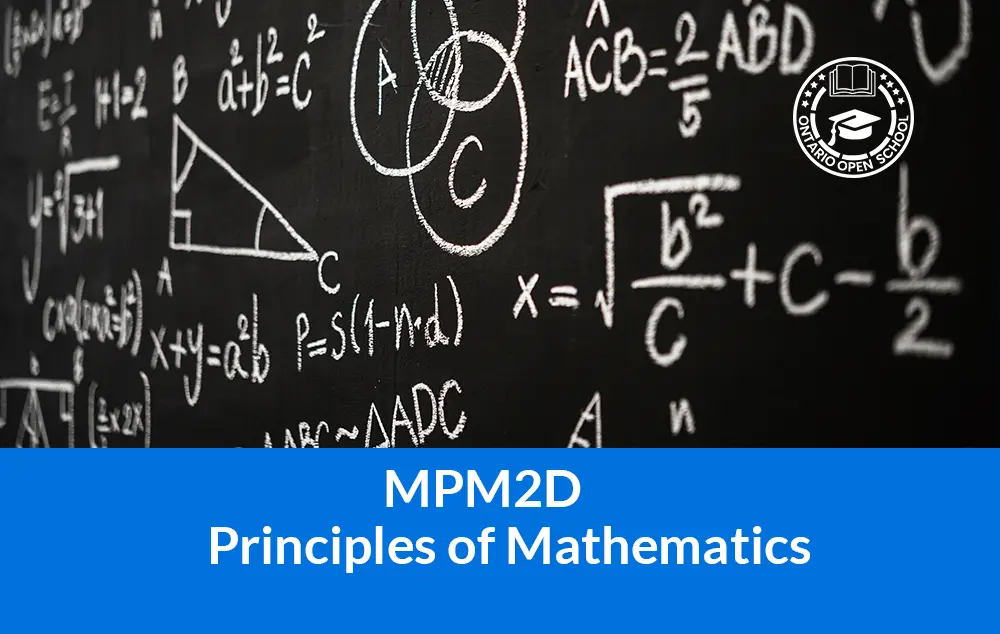- info@ontarioopenschool.com
- 647-494-4499
-
Unit 100 - 29 Gervais Drive, North York, ON.
M3C 1Y9
Copyright 2024 Ontario Open School Inc. All Rights Reserved.
This course enables students to broaden their understanding of relationships and extend their problem-solving and algebraic skills through investigation, the effective use of technology, and abstract reasoning. Students will explore quadratic relations and their applications; solve and apply linear systems; verify properties of geometric figures using analytic geometry; and investigate the trigonometry of right and acute triangles. Students will reason mathematically and communicate their thinking as they solve multi-step problems.
Unit Order | Unit Name | Suggested Time |
|---|---|---|
| Unit 1 | Strand B: Linear Systems Linear relationships are not only important to understand for everyday use – understanding the interplay between distance and time for the calculation of speed, or rates of change in business, for example. Linear relationships are also fundamental to more complex forms of mathematics. This unit reviews the concepts of linear algebra that were developed in Grade 9, and expands upon important procedures such as rearranging equations and developing accurate graphs. | 15 Hours |
| Unit 2 | Strand B: Analytical Geometry Expanding upon the foundation built in the last unit, the equations of lines and line segments will be examined. Developing logical and mathematical methods for determining line segment length and midpoint, based upon an equation or upon coordinates, will enable a deeper study of geometric shapes and properties. | 15 Hours |
| Unit 3 | Strand B: Algebraic Skills To progress beyond a certain point in any mathematics, some rather advanced algebraic skills must first be mastered. In this unit, students will consider various operations on monomials, binomials and polynomials. The factoring of binomials and trinomials will be studied. | 15 Hours |
| Unit 4 | Strand A: Quadratic Functions Until this point, all algebraic relations that have been considered have been linear. In this unit, second-order functions are introduced. The concept of the function will be studied; the domain, range and simple transformations of quadratic functions will be explored; and students will learn how to complete the square. | 16 Hours |
| Unit 5 | Strand A: Quadratic Equations Having explored quadratic functions graphically, the algebra of quadratic equations will be considered. The Quadratic Formula, which will be used extensively throughout all future math courses, will be derived and used. | 20 Hours |
| Unit 6 | Strand C: Trigonometry Triangles have a particularly significant role to play in mathematics. This unit is all about triangles and how they can be used to describe many phenomena in the universe. A review of Pythagorean Theorem will start the discussion, which will lead the student through sine, cosine and tangent ratios, the sine law and cosine law, and the ability to solve problems using these tools. | 22 hours |
| Final Evaluation 30% | Final Assignment Final Exam
| 5 hours 2 hours |
| Total | 110 Hours |
A wide variety of instructional strategies are used to provide learning opportunities to accommodate a variety of learning styles, interests and ability levels. These strategies include, but are not limited to:
|
Oral Presentation Discussion Socratic Lesson Independent Study Research Process Computer Assisted Instruction |
Think Pair Share
Visual Stimuli Note Making Scientific Method Media Presentation |
Reflective discussion Lecture Worksheet Inquiry Process Brainstorming |
Purpose
The primary purpose of assessment is to improve student learning. Assessment relates directly to the expectations for the course.
A variety of assessments for and as learning are conducted on a regular basis to allow ample opportunities for students to improve and ultimately demonstrate their full range of learning and for the teacher to gather information to provide feedback. Assessment tasks relate to the success criteria set out in lesson plans. Success criteria allow students to see what quality looks like.
Evaluation is the process of judging the quality of student work in relation to the achievement chart categories and criteria and assigning a percentage grade to represent that quality. Evaluation is based on gathering evidence of student achievement through:
Assessment for Learning – we provide feedback and coaching. Assessment FOR Learning is the process of seeking and interpreting evidence for the use of learners and their teachers to decide where the learners are in their learning, where they need to go, and how best to go there.
Assessment as Learning – we help students monitor progress, set goals, reflect on their learning
Assessment AS Learning is the process of the explicit fostering of students’ capacity over time to be their own best assessors, but teachers need to start by presenting and modeling external, structured opportunities for students to assess themselves.
Assessment of Learning – we use assessments to provide evaluative statements about student achievement. Assessment OF Learning is the assessment that becomes public and results in statements of symbols
(marks/grades/levels of achievement) about how well students are learning. It often contributes to pivotal decisions that will affect students’ future.
ASSESSMENT TOOLS
Strategies for Assessment and Evaluation of Student Performance
|
|
|
|
|
|
|
|
|
|
|
|
|
|
|
| Strand | Duration | Overall Expectations | AFL | AAL | AOL | K
25% |
A
25% |
C
25% |
T 25% |
||
|
70% |
A | 54 hours | A1-A4 | Student-Teacher Conferencing | KWL Chart
Peer Assessment |
Unit Test
Assignment Mini Test |
√ | √ | √ | √ | |
| B | 32 hours | B1-B3 | Diagnostic Worksheet
Class Discussion |
KWL Chart
Peer Assessment |
Unit Test
Assignment Mini Test |
√ | √ | √ | √ | ||
| C | 24 hours | C1-C3 | Socratic questioning | KWL Chart
Peer Assessment |
Unit Test
Assignment Presentation |
√ | √ | √ | √ | ||
| 30% | A1-C3 | Final Evaluation 30% |
√ |
√ |
√ |
√
|
|||||
Resources
Growing Success: Assessment, Evaluation and Reporting in Ontario Schools (2010)
http://www.edu.gov.on.ca/eng/policyfunding/growSuccess.pdf
Principles of Mathematics 10 (Nelson Education Ltd., 2010).
Principles of Mathematics 10 (McGraw-Hill Ryerson, 2007).
Moodle Website
Dictionaries, Thesaurus etc.
Grading
Weighting of categories
| Knowledge/Understanding | Thinking/Inquiry | Communication | Application |
| 25% | 25% | 25% | 25% |

Course Grade | Grade 10 |
|---|---|
Course Code | MPM2D |
Course Category | Mathematics |
Course Type | Academic |
Course Delivery | Online |
Course Duration | 8hrs |
Course Credit | 0 |
Copyright 2024 Ontario Open School Inc. All Rights Reserved.
